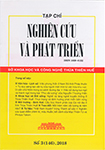Tư duy sáng tạo văn tự của người Việt nhìn từ văn hóa khu vực: Di sản chữ Nôm trong so sánh đương đại.
Tóm tắt
Bài viết này như là một sơ kết trên đường nhận thức về đặc trưng và vị trí của chữ Nôm Việt trong phương diện tư duy sáng tạo chữ viết ở vùng văn hóa chữ Hán, từ trải nghiệm trong thực tế nhiều năm học tập chữ Hán và “chữ Nôm” của một số tộc người trong vùng. Kết hợp trải nghiệm đó với việc tham khảo các nghiên cứu về cấu tạo và quá trình phát triển của những loại văn tự tự tạo khác (cùng sáng tạo hay được gợi ý từ nền tảng là chữ Hán, như văn tự Khiết Đan, Nữ Chân, Tây Hạ,…), bài viết chỉ ra thực tế rằng, ở thời điểm hiện tại, cùng với chữ Hán trong Hán ngữ hiện đại ở Trung Quốc, thì chỉ có hai loại chữ phái sinh từ chữ Hán được sử dụng làm văn tự quốc gia chính thức, là Hanguel ở Triều Tiên và Kana ở Nhật Bản, còn các loại văn tự khác (gồm cả chữ Nôm Việt) đều đã trở thành “văn tự chết”. Trước nay, chữ Nôm Việt thường được xem trọng ở điểm “là tinh hoa sáng tạo” hay “gia tài văn hóa quý báu” của người Việt. Từ góc nhìn khu vực học mang tính đương đại, ở đây, chúng tôi thử đưa ra một so sánh về cấp độ trong tư duy sáng tạo văn tự của người Việt với các tộc người trong cùng khu vực. Sự tương đối hóa này là cần thiết trong nhận thức về chữ Nôm Việt, đặc biệt là từ cách tiếp cận của nhân loại học lịch sử (văn hóa sử, historical anthropology) và nhân loại học chữ viết (anthropology of writing) - các phân ngành nhân loại học đặt quan tâm nhiều tới các xã hội có tính văn tự cao, ở đây là vùng văn hóa chữ Hán ở Đông Á. Trong nội bộ khoa học xã hội Việt Nam, đến thời điểm hiện tại, sau rất nhiều năm tháng tích lũy và chuẩn bị, đã đến lúc chúng ta có đủ điều kiện để có thể so sánh một cách vừa tổng quan vừa kỹ lưỡng chữ Nôm Việt với các văn tự trong khu vực và trên toàn thế giới. Chữ Nôm của người Việt, trên thực tế sử dụng, đã là vấn đề thuộc về quá khứ. Nhưng nhận diện một vấn đề đã thuộc về quá khứ như Nôm Việt, không phải vì quá khứ, mà là một công việc cần thiết không thể không thực hiện để hướng đến đích đương đại, cho đương đại.ABSTRACT
CREATION OF SCRIPT BY VIETNAMESE PEOPLE FROM THE PERSPECTIVE OF REGIONAL CULTURE: VIETNAMESE NÔM SCRIPT TREASURE
This paper is a preliminary summary on the path to understanding the characteristics and position of the Vietnamese Nôm script in terms of script creation in the Han script culture through personal experiences of many years of studying the Han script and Nôm script of some ethnic groups in the region. By combining the personal experiences with a reference to researches on the composition and development of other types of self-created scripts (either jointly created or suggested from the Han script, such as the Khitan script, the Nurchen script, Tangut sctipt,…), the paper points to the fact that, at the present time, along with the Han script in modern Chinese in China, there are only two derivatives of the Han script which are used as the official national script, namely Hanguel in Korea and Kana in Japan, while other scripts (including the Nôm script) have become "dead scripts". In the past, the Vietnamese Nôm script was honored as the "creative quintessence" or "precious cultural treasure" of Vietnamese people. From the perspective of the contemporary regional studies, here we try to give a comparison of the level of script creation of Vietnamese people with that of other ethnic groups in the same region. This relativization is necessary in the understanding of the Vietnamese Nôm script, especially from the perspective of historical anthropology (historical culture and historical anthropology) and anthrophology of writing. Branches of anthropology focus on societies with high levels of script, which is the Han script-based cultural area in East Asia.At the present, after many years of accumulation and preparation, it is time for us, researcher within the Vietnamese social sciences, to compare the Vietnamese Nôm script to other scripts in the region and around the world in a comprehensive and well-worded manner. Vietnamese Nôm script, in fact, belonged to the past, but identifying a problem that has belonged to the past as Vietnamese Nôm script is not for the past, it is a necessary work to aim at the modern time.

